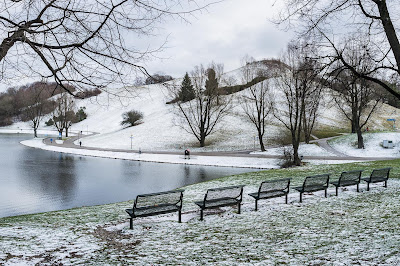For this exercise I have gone back to a set of images originally taken for Project 18, a study of the Autobahn and a group of office buildings behind which the sun was setting. Here are 3 of the original photos showing the progression I was attempting to capture.
The objective was to capture the changing light in the sky and study how the foreground artificial lighting becomes more prominent in the exposures as the ambient light diminished. The price that is paid is an almost complete loss of foreground detail, even in the earliest shot.
However, what if the goal had been to portray the road and buildings against the sky, but without loss of detail in the buildings. Looking at the histogram for this image, we have over and under exposure in the same frame with loss of detail at both ends of the scale - the exposure is actually fine, but we have run out of dynamic range in the camera
Starting with the initial shot the first thing to do is to adjust the image to optimize the background cloud and sun:
The problem this has induced is that the buildings are now even darker. I can adjust that by increasing the shadow levels, but at the expense of adjusting my finely tuned sky tones:
Also at this stage the buildings are still too dark, but any further processing would ruin the sky. At this stage I painted in an adjustment mask:
This now meant that I could adjust the foreground exposure independently of the background. I lifted the exposure by 1.5eV reduced some of the highlights, added in some shadow detail and increased the clarity slider:
I may have overdone it, the image is starting to take on something of the look of an HDR image, but is I think still acceptable. It is surprising how much shadow detail existed in the image and how powerful a tool Adobe Lightroom is for making these types of adjustment. I am now getting to the point where Photoshop is simply a printing engine.
Returning to the original theme of B&W, here is the straight conversion from the final colour image
I have then pushed the boundaries much further than with the colour image, again I am hitting the edge of obvious fakery, but the B&W image is still an interesting photograph, we know it is wrong, but it is wrong in an interesting way.
So, I did not do any printing for this exercise, but that was not really the goal, the objective of this and the previous exercise is to learn how to make selective changes to the exposure of a single frame. In the days of film this needed to be done at the printing stage, digital processing now enables that to happen at the development stage. It is not all rosy in the Digital garden, over use of these tools makes something of a dog's dinner, however, subtly done they can transform a photograph.
Often times people talk about rescuing an image with these techniques, sure that can be useful. However, I would contend that the real value of the these techniques comes from enabling us to make images in far more marginal exposure conditions than would have formerly been the case, secure in the knowledge that a second exposure process can be applied. This is not an excuse for sloppy exposure management in the camera but a real creative option that extends the capabilities of photography.




















































